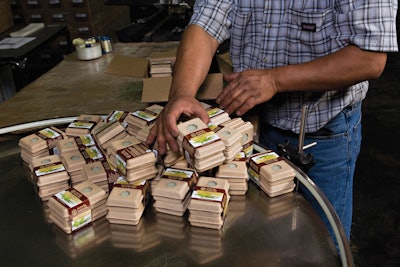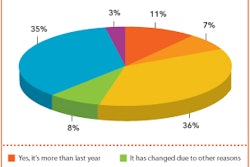Some consumer packaged goods (CPG) companies are quietly looking beyond the top-of-mind capabilities typically associated with contract packagers and digging deeper for “under the radar” specialty services. Why? Not everything goes according to plan. Packages get mislabeled. Products can get chipped or scratched when shipped with inadequate packaging protection.
The one-of-a-kind package rework and returns-handling orders that these circumstances generate are carried out most efficiently on hand-assembly lines. CPG company purchasing managers might overlook these low-tech emergency operations during their contract packager qualification audits while signing off on meatier requirements such as automation capabilities, production capacity, and clean-room regulation compliance.
Then the unexpected happens, and retailer fines loom for receiving only part of a product order, a situation known in distribution channels as “short-shipping.” An affected product manufacturer enters “gotta have it fixed, and now!” mode. When that happens, the manufacturer might call on a contract packager like Premier Packaging (www.premierpackaging.com) to perform highly customized make-good work.
Premier Packaging, an 11-year-old company occupying 80,000 sq ft of space in Memphis, TN, provides a range of packing services, from shrink-wrapping to clamshell and blister-card packaging to bundling, and pick-and-packing. But it also functions as a custom hand-assembly troubleshooter for consumer packaged goods, even taking on packaging-related challenges with items as diverse as bed frames and auto parts for companies ranging from Fortune 500s to mom-and-pop operations.
Focus: quality assurance
“With our ability to generate a 500-person workforce very quickly that is packaging-knowledgeable, we are a good fit for people who are in a distressed situation,” says Bill McNeil, president of Premier Packaging. “We are at our best when turning around specific projects by hand.”
Many of these projects involve quality assurance; somehow, the product was not packaged according to plan. Often, these faulty packaged products arrive from overseas and are bound for U.S. retail or distribution centers. When rework is needed, it can be more cost-effective to divert these shipments to a co-packer, such as Premier Packaging, rather than return them to their place of origin.
It’s not a proud moment when a CPG company needs to consult a contract packager for troubleshooting services, McNeil explains. So he discusses specific projects without divulging names of the product manufacturers or providing too many details. Even so, the nature of the work performed lends insight into an especially fluid operation that can co-exist with a co-packer’s semi-automated bagging, bundling, and shrink-wrapping lines.
During Contract Packaging’s recent visit, Premier Packaging was completing one such hand-assembly project. An office product marketer’s magnetic combination boards had arrived in shipping cases. The boards were packed individually in shrink-wrap, with a product-information sheet adhered to the shrink film. The sheet described the boards’ dimensions as 17” x 23”, but the actual size was 15.5” x 23”, so the erroneous sheets had to be removed from the packages and replaced.
A six-person team of hand-assembly operators worked a production line that began with the boards being pulled from their shipping cases. At subsequent stations, the incorrect P-O-P information sheets were removed from the shrink-wrap and replaced with correct sheets. The boards then were returned to the master cases, sealed, and prepared for shipment.
“Who pays for this kind of work? It’s not the product manufacturer; they’re our customer. Some factory overseas is paying us to do this,” McNeil says. “That factory is probably paying more for us to fix it than it cost him to package it in the first place. But he either has to tell the product manufacturer to dump it or short-ship the order. The manufacturer says, ‘Walmart is going to fine me for lost sales, for short-shipping them.’ So the overseas supplier says, ‘Have the co-packer bill me, but have him fix it because now all I have to do is pay the co-packer what it costs to fix it.’ He doesn’t have to pay what it would cost him in fines for lost sales or short-shipping.”
Value services
McNeil lists two additional examples that show the value of the troubleshooting capabilities of a contract packager:
• Repacking. This is a service that some contract packagers provide by removing products from current packaging and then inserting them into new packaging, sometimes arranging them in a different configuration.
McNeil recounts a recent situation when a manufacturer’s individual soap bars weren’t selling under one brand name at a $1 price point in dollar stores. So the manufacturer, working with a design agency, created a more attractive carton and shipped all the components to Premier Packaging for making a change to upgraded packaging. Hand assemblers removed the soap bars from the discarded packaging, wrapped each one in colorful tissue paper, packed them individually in the new cartons, then prepared them for shipment to stores. The soap, marketed under a new brand name, is moving off store shelves—at $9.99 per carton.
• Returns handling. Contract packagers sometimes are asked to make minor modifications to consumer products, with packaging services also being part of the job. Premier Packaging recently received a product manufacturer’s shipment of cappuccino makers containing the wrong computer chip in the appliance’s digital instruction screen.
Hand assemblers opened each carton and removed the cappuccino maker, opened the appliance, swapped out the erroneous chip for a correct one, repacked the cappuccino makers in their cartons, and shipped them to retail stores and distribution centers.
Such extremely customized work requires an especially careful attention to detail, and McNeil says everything about the operation receives a personal touch. If you contact the company, you’re likely to talk to either McNeil, who handles new-business development, or General Manager Carri Lane, who tracks each project through to completion.
“Our customers deal with one person 99% of the time,” Lane notes.
Personal attention to detail also is evident in the approach to measuring productivity on assembly lines and bidding projects.
“On each of our lines, we typically put one supervisor for 10 people,” McNeil explains. “That supervisor does an hourly count to give me an idea where that line is on the project. So within an hour, I know what my adjustments need to be—or I can see what else I can do to improve the line’s operation.”
Project bidding combines McNeil’s knowledge of his temporary work force—many of his hand assemblers work regularly for Premier Packaging—and his own assessments of his line workers’ capabilities.
“I look at every project based on the thought that if I did it myself, how quickly would I do it? If I can do ‘X’ amount of pieces in one minute, then I am going to bid it at ‘X’ amount of pieces in 50 seconds, because I know the people on my line can do it faster than I can,” McNeil notes. “Once they get their fingers nimble, they will be able to shave 20% off the time, which I couldn’t do.”
At a time when many packaging operations are becoming more automated, contract packagers such as Premier Packaging show evidence that CPG companies, looking for “under the radar” unique services, continue to find real value in highly customized assembly operations that are best performed by hand.
“I just use a common-sense approach to packaging,” McNeil says.

























